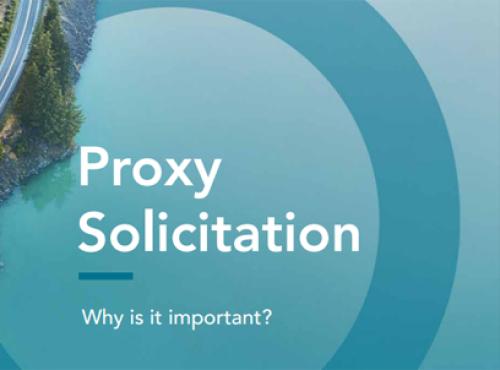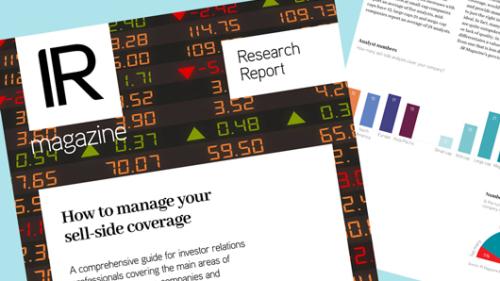As IR has eveolved, so the metrics for measuring IR performance have grown in number and sophistication.
It’s a fuzzy business, IR, as much art as science, with no revenues, profits or margins to judge its performance. Stock price is a lousy yardstick; even the world’s best communicator can’t turn a mutt into best in show. Average analysts’ ratings – sometimes used to calculate an IRO’s bonus – can be decimated by one missed quarter. So when it’s time for a raise or a bigger budget, what’s an IRO’s ROI?
As IR has evolved into a strategic discipline stacked with MBAs and CFAs, IR performance metrics have also grown in sophistication. When Michael Haase took on IR at Advanced Micro Devices (AMD) in 2002, he established specific goals and presented them to his new bosses at the California chip maker, including monitoring and measuring the ‘quality’ of AMD’s institutional investor base.
‘We had a crummy shareholder base,’ recalls Haase, who left AMD in November 2007 to lead IR at VMware. ‘There were a lot of fast-money hedge funds and momentum investors actively trading the stock and we were not attracting long-term investors. I wanted to improve the quality of the shareholder base and define how the quality would be measured.’
AMD’s institutional ownership looked in good shape, but when Haase drilled down behind names like Fidelity and Merrill Lynch, he found that some individual mutual funds had an average portfolio turnover higher than 300 percent, meaning a holding period of only four months. The weighted average turnover of AMD’s top 50 mutual fund holders was 107 percent, or a holding period of 11 months.
‘Compared with peer firms in the semiconductor industry, we were last,’ Haase says. ‘Everyone else was between 15 and 30 months. Our goal was to improve that 11-month holding period.’ He whittled the global investment universe down to 100 low-turnover target funds and set out to reshape AMD’s investor profile.
Peer review
Sometimes IR metrics are tied into wider company processes. Montreal-based CGI Group’s IR program, led by Lorne Gorber, is ISO 9001-certified for quality management and measurement, like all of CGI’s IT-related operations.
When Janet Craig joined Canada’s Nortel Networks as investor relations chief in August 2007, the company had been through a series of wrenching restatements going back to 2001. Craig’s main goal was to haul Nortel’s investor outreach up to a decent level of ‘engagement’. She began by benchmarking Nortel’s schedule of one-on-ones, investor conferences and analyst days against S&P 500 and S&P/TSX 60 companies in Rivel Research Group’s ‘Perspectives on investor communications’.
Craig also studied the IR programs of Nortel’s closest telecoms equipment peers by looking at their websites and talking to analysts. ‘I asked them who had the best IR in the business and why,’ she says. ‘Transparency, outreach and knowledge – was there some kind of secret sauce?’
She concluded that Nortel’s IR program was in the bottom 10th percentile. After a year of concerted effort, she reckons Nortel is now between the 40th and 50th percentile; her goal is the 75th percentile.
Brian Rivel, president of Rivel Research Group in Westport, Connecticut, argues against metrics like counting the number of meetings. ‘It’s not the stock price or the number of meetings,’ he insists. ‘It’s whether a firm’s audiences are hearing its message.’
Rivel’s investor perception studies ask investors and analysts about the effectiveness of a company’s investor communications, the responsiveness of the IR team and the quality of disclosure. After repeating the studies and comparing them against the aggregate scores of hundreds of other companies, IR teams can measure progress and benchmark themselves against their peers.
Tech buzz
Back in 2002 when Haase started his number crunching at AMD, he did it all himself. Today market intelligence firms are streamlining the process. ‘Productivity’ has been a big buzzword for the past few years, says Peter Juhng at Ilios Partners, whose IRNavigator customer relationship management (CRM) system integrates shareholder ID. ‘It can identify meaningful trends and assess the effectiveness and success of meetings,’ Juhng says.
Ipreo has built reporting into its new CRM platform, BD Corporate, so IROs can instantly download and print out progress summaries, says O’Hara Macken, global head of corporate products. There’s a lot of smart and relevant functionality built in, he notes, adding that Ipreo’s approach to market intelligence is based on ‘correlating activity in the marketplace to certain behavior by investors and giving companies better indications of how effective their IR is.’
Haase’s initial analysis at AMD spawned dozens more charts and graphs for his CFO, CEO and board to digest in formal twice-yearly reports, covering everything from the outcome of specific meetings to overall results: a drop in high-turnover holders and a decrease in hedge fund ownership.
By 2007, 12 of AMD’s top 25 institutional shareholders were new, targeted, long-term firms. International ownership had increased from 3 percent to 11 percent of the total and analyst coverage had doubled to more than 30. Above all, after five years of steady progress, Haase had a starkly clear, measurable bottom line: the weighted average holding period of AMD’s top 50 mutual fund holders had improved from 11 months to 27 months.
All the hits, all the time
‘It’s one of the most common questions we get: how does a company or an internal IR team know whether it is doing a good job?’ says Don Duffy, president of ICR, an IR consulting company.
ICR likes to say it provides real-time perception feedback because its consultants are constantly in conversation with corporate executives and investment pros across different industries. Recently the firm has gone a step further – into cyberspace.
Timothy Carey, senior vice president of digital media, explains that ICR is using ‘social media analytics’ to track message boards and blogs as well as regional, national and global news. Even YouTube videos and Facebook pages enter the mix. ‘We’re keeping on the pulse of what’s being said about companies and their brands,’ Carey says.
ICR starts by scouring the web for mentions of a firm and its peers and identifying influential sources like certain trade magazines or blogs. Then it starts tracking the sentiment about its client’s stock on those sites. The success of an earnings call, investor conference webcast or analyst day can then be evaluated by looking at its impact on the sentiment percolating up through the web. ‘The important thing is that we track more than just opinions on financial performance,’ Carey adds.
By the numbers
Ideas for quantitative performance metrics
- One-on-ones, phone calls and emails with top 50 shareholders
- Contacts with potential new shareholders
- Sell-side analyst coverage
- Participants at analyst days and site visits
- Website visitors
- Response time to investor questions
- Non-deal roadshows
- Presentations at key investor conferences
Source: Andreas Goldau, Cisco Systems
View from the top
Most important metrics in measuring IR effectiveness according to US CEOs
- Feedback from the investment community
- How well message is registering
- Valuation/stock price
- Ability to develop relationships with the investment community
- Extent/quality of coverage
- Ability to communicate
- Visibility/meeting frequency
- Shareholder retention/makeup of shareholder base
Source: 'Perspectives from the CEO', Rivel Research Group
View from outside
From the perspective of the investment community, what could IR do better?
Buy side
1 Disclosure
2 Transparency
3 Company knowledge
4 Responsiveness
5 Website
Sell side
1 Disclosure
2 Responsiveness
3 Transparency
4 Company knowledge
5 Proactivity
Source: IR magazine's Investor Perception Study, US 2008










